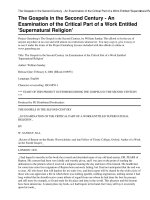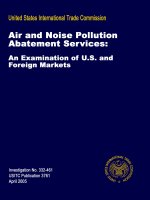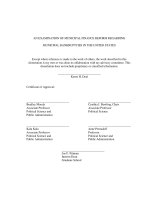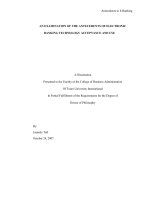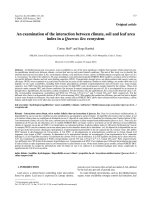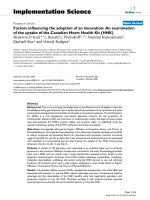An examination of the long run market reaction to the announcement of dividend omissions and reductions
Bạn đang xem bản rút gọn của tài liệu. Xem và tải ngay bản đầy đủ của tài liệu tại đây (5.23 MB, 121 trang )
INFORMATION TO USERS
This manuscript has been reproduced from the microfilm master. UMI films
the text directly from the original or copy submitted. Thus, some thesis and
dissertation copies are in typewriter face, while others may be from any type of
computer printer.
The quality of this reproduction is dependent upon the quality of the
copy submitted. Broken or indistinct print, colored or poor quality illustrations
and photographs, print bleedthrough, substandard margins, and improper
alignment can adversely affect reproduction.
In the unlikely event that the author did not send UMI a complete manuscript
and there are missing pages, these will be noted. Also, if unauthorized
copyright material had to be removed, a note will indicate the deletion.
Oversize materials (e.g., maps, drawings, charts) are reproduced by
sectioning the original, beginning at the upper left-hand comer and continuing
from left to right in equal sections with small overlaps.
ProQuest Information and Learning
300 North Zeeb Road. Ann Arbor, Ml 48106-1346 USA
800-521-0600
Reproduced with permission of the copyright owner. Further reproduction prohibited without permission.
Reproduced with permission of the copyright owner. Further reproduction prohibited without permission.
An Examination of the Long-run Market Reaction to the Announcement of
Dividend Omissions and Reductions
A Thesis
Submitted to the Faculty
of
Drexel University
by
Yi Liu
in partial fulfillment o f the
requirements for the degree
of
Doctor o f Philosophy
June 2003
Reproduced with permission of the copyright owner. Further reproduction prohibited without permission.
UMI Number 3086406
Copyright 2003 by
Liu, Yi
All rights reserved.
UMI*
UMI Microform 3086406
Copyright 2003 by ProQuest Information and Learning Company.
All rights reserved. This microform edition is protected against
unauthorized copying under Title 17, United States Code.
ProQuest Information and Learning Company
300 North Zeeb Road
P.O. Box 1346
Ann Arbor. Ml 48106>1346
Reproduced with permission of the copyright owner. Further reproduction prohibited without permission.
© Copyright 2003
Yi Liu. All Rights Reserved.
Reproduced with permission of the copyright owner. Further reproduction prohibited without permission.
Drexel University
O ffice o f Research and Graduate Studies
Thesis Approval Form
(For Masters and Doctoral Students)
Hagerty Library will bond a copy of this form with each copy of your thesis/dissertation.
This thesis, entitled / \ r \
yyin.r'ti-eyC
zf^<-
^~ ory
CD
~~
_____
erf'
Q'l *____________________________________
and authored by
______________, is hereby accepted and approved.
Signatures:
Chairman,
'.haiman, Exai
Examining Committee:
-^JC an*'
Supervising Professor:
(^J
Committee Members:
A M * * ______
k « - ___________ ______________
k $ r<
Progrhm Advisor:
Department Head:*
_ f]
%JC{ %eJ>JL,
This document is available at xeLedu/graduate/forms/phd.aso
Reproduced with permission of the copyright owner. Further reproduction prohibited without permission.
Dedications
To m y wife
... w ith love
Reproduced with permission of the copyright owner. Further reproduction prohibited without permission.
ili
Acknowledgements
Many thanks go to my chair Dr. Samuel Szewczyk for leading me into this area.
Without his insights and support, I would never be here. I am extremely grateful to Dr.
Zaher Zantout. Thank him for working with me until 6 a m.. Thank him for checking
every detail o f the tables. His continuous critiques shaped the paper.
I would like to thank my committee members Dr. Michael Gombola, Dr. Edward
Nelling and Dr. Linhui Tang for their suggestions. Dr. Jacqueline Gamer shows me how
a SAS Jedi Warrior is willing to help and does help others. A debt o f gratitude is owed to
Dr. Amie Cowan, who developed Eventus, and tailored it to me. My colleague. Dr.
Elizabeth Webb, who is to be a social responsible professor, makes jokes to make the
four-year journey shorter.
I would like to thank my wife. Without her, I will still be in the dark side. I hope
tremendous time I spent on the dissertation does not separate, but combine us.
I want to thank my mother and sister, although they are not physically with me.
Their support does not reduce through thousands o f miles away. The power o f their
encouragement is proportional to the square o f the distance, according to the universal
law o f love.
There are times o f overwhelming excitements, and times o f overwhelming
frustration. This dissertation has become the essential part o f my life in two years. It is
the life and the entertainment for me. I am very happy that by the end, I don’t hate the
paper as I expected. I changed my mind o f throwing it into trash can, but instead would
publish it somewhere.
Future follows random walk (Fama, 1998), who can tell?
Reproduced with permission of the copyright owner. Further reproduction prohibited without permission.
Table of Contents
List o f Tables.........................................................................................................................VII
List o f Figures.....................................................................................................................V m
A bstract...................................................................................................................................IX
Chapter 1: Literature Review...................................................................................................I
1.1 Introduction........................................................................................................................ 1
1.2 Literature on dividend policy........................................................................................... 4
1.2.1 Irrelevance o f dividend policy...................................................................................4
1.2.2 Information related explanation.................................................................................5
1.2.3 Agency cost based explanation..................................................................................6
1.2.4 Behavioral finance and dividend policy....................................................................7
1.2.5 Other explanations..................................................................................................... 8
1.2.6 The trends o f dividend payout through tim e ...........................................................9
1.3 Theoretical models concerning overreaction and underreaction.................................. 10
1.4 Review o f empirical evidence on overreaction and underreaction............................... 14
1.4.1 Empirical evidence o f autocorrelation o f stock returns......................................... 15
1.4.2 Empirical evidence o f underreaction and overreaction.........................................16
1.4.3 Summary on empirical evidence............................................................................. 20
Chapter 2: M ethodology...................................................................................................... 21
2.1 Methodologies review................................................................................................... 21
2.1.1 Defining the normal return: time series vs. cross-sectional approach..................21
2.1.2 Calculating the abnormal return across time: CAR vs. BHAR............................ 24
2.1.3 Calculating abnormal return across sample firms: VW vs. EW ........................... 26
Reproduced with permission of the copyright owner. Further reproduction prohibited without permission.
V
2.1.4 Drawing inferences.................................................................................................. 27
2.1.5 Time-series regression..............................................................................................30
2.2 Our methodology.............................................................................................................32
2.2.1 Buy-and-hold abnormal returns...............................................................................32
2.2.2 Calendar time portfolio approach........................................................................... 35
Chapter 3: Data.......................................................................................................................37
3.1 Sample construction.........................................................................................................37
3.2 Matched firm selection.................................................................................................... 39
3.2.1 Matched by siz e ....................................................................................................... 39
3.2.2 Matched by size and industry..................................................................................39
3.2.3 Matched by size and prior performance................................................................. 40
3.2.4 Matched by industry and prior perform ance..........................................................42
3.2.5 Matched by size, industry and prior perform ance................................................. 42
3.2.6 Matched by size and book-to-market ratio............................................................. 42
3.2.7 Matched by size and leverage..................................................................................43
Chapter 4: Market reaction following announcements..................................................... 45
4.1 Announcement abnormal returns....................................................................................45
4.2 Post-announcement results using buy-and-hold matching methodologies................46
4.2.1 Post-announcement results during the whole sample period................................46
4.2.2 Are abnormal results caused by mis-matching ? ................................................... 48
4.3 The duration and magnitude o f long-run abnormal returns......................................... 49
4.4 Post-announcement results using Fama-French calendar time portfolio approach
51
4.5 Conclusions..................................................................................................................... 53
Reproduced with permission of the copyright owner. Further reproduction prohibited without permission.
Chapter 5 : The determinants o f long-run abnormal returns............................................... 55
5.1 Introduction......................................................................................................................55
5.2 Are abnormal returns subject to chance? Robustness test across sub-periods........... 57
5.2.1 Sub-periods by every three years........................................................................... 57
5.2.2 Sub-periods by economic conditions.....................................................................58
5.2.3 Fading dividends and fading market reaction.........................................................60
5.2.4 Major political and economic events and market reaction.................................... 62
5.3 Univariate analysis.......................................................................................................... 63
5.3.1 Post-announcement changes in risk ........................................................................63
5.3.2 Are long-run abnormal returns only concentrated on small size firm s?.............. 64
5.3.3 Are long-run abnormal returns related to the reasons cited?.................................67
5.3.4 Long-run abnormal returns and dividend y ield..................................................... 68
5.3.5 Announcement abnormal returns and long-run abnormal return.......................... 70
5.4 M ultivariate analysis....................................................................................................... 71
5.4.1 M ultiple regression on the determinants o f short-run market reaction................. 71
5.4.2 Multiple regression on the determinant o f long-run market reaction....................73
5.5 Conclusions..................................................................................................................... 76
List o f References.................................................................................................................. 78
Appendix A: Tables...............................................................................................................83
Appendix B: Figures............................................................................................................ 102
V ita....................................................................................................................................... 106
Reproduced with permission of the copyright owner. Further reproduction prohibited without permission.
vii
List of Tables
1. Literature Review........................................................................................................... 83
2. Chronological Distribution and Industry Representation............................................ 85
3. Mean Values o f Matching Criteria for Event Firms and Matched Firm s................. 86
4. Announcement Abnormal Returns and Post-Announcement Risk Changes...............87
5. Post-Announcement Long-run Abnormal Returns....................................................... 88
6. Duration o f Post-Announcement Long-run Abnormal R eturns................................. 89
7. Post-Announcement Monthly Abnormal Returns........................................................ 90
8. Abnormal Returns by Sub-periods...............................................................................91
9. Abnormal Returns by the Condition o f the Stock M arket.......................................... 93
10. Abnormal Returns, by Sub-Samples Defined By Period o f Announcement.......... 94
11. Abnormal Returns, by Sub-Samples Defined by Changes in R isk..........................95
12. Abnormal Returns, by Sub-Samples Defined by Firm S ize.................................... 96
13. Abnormal Returns, by Sub-Samples Defined by Reasons........................................97
14. Abnormal Returns, by Sub-Samples Defined by Dividend Yield............................98
15. Abnormal Returns by Announcement Abnormal Returns........................................99
16. Regression Analysis o f the Announcement Abnormal Returns............................ 100
17. Regression Analysis o f the Post-Announcement Abnormal Returns.....................101
Reproduced with permission of the copyright owner. Further reproduction prohibited without permission.
List of Figures
1.
How the Horizon o f Holding-Period Long-Run Abnormal Returns is
Overstated.............................................................................................................. 102
2.
How the Horizon o f Long-Run Abnormal Returns is Overstated When
Using Fama-French Calendar Portfolio Approach............................................. 103
3 A. Two-Day Average Announcement Abnormal Returns by Sub-Periods
104
3B. The Average Two-Day Announcement Abnormal Returns and Average
Percentage o f Firms Paying Dividends By Sub-Periods.................................... 105
Reproduced with permission of the copyright owner. Further reproduction prohibited without permission.
Abstract
An Examination o f the Long-run Market Reaction to the Announcement
o f Dividend Omissions and Reductions
Yi Liu
Samuel H. Szewczyk, Supervisor, Ph.D.
This study investigates the long-run stock performance following dividend
omissions and reductions, and looks for answers for three questions: 1) Does the market
underreact to announcement o f dividend omissions and reductions? 2) if the market does,
how long does it take for the market to correct this underreaction, and 3) are there any
factors that influence the long-run underperformance?
We document significantly negative long-run abnormal stock returns for up to
five years after announcement by using either holding period matching approach or
Fama-French calendar time portfolio regression. The results are robust across time
periods and methodologies. However, we find the horizon o f long-run post
announcement abnormal returns might be overstated in prior literature. When looking at
each year individually, we find the abnormal performance is confined in the first
postannouncement year. The long-run postannouncement abnormal returns beyond the
first year reflect the compounding effects for buy-and-hold methodology and averaging
effects for Fama-French calendar time regression. Our findings provide empirical support
for the argument presented by Fama (1998) that the horizon o f long-run anomaly is
severely overstated. We find several factors that influence short-term market reaction to
announcement o f dividend omissions and reductions. However, most o f these factors
have no impact on the long-run abnormal stock performance. The magnitude o f
Reproduced with permission of the copyright owner. Further reproduction prohibited without permission.
X
underreaction is not associated with percentage o f dividend changes, reason for dividend
changes, dividend yield or firm risk changes around announcement.
Our paper also makes an important contribution in methodology: We caution
future researchers o f long-run abnormal stock performance to be aware o f the fact that
both buy-and-hold matching methodology and Fama-French calendar time portfolio
regression tend to overstate the magnitude and horizon o f long-run abnormal
performance.
This paper contributes to the on-going debates about the validity o f Efficient
Market Hypothesis.
Reproduced with permission of the copyright owner. Further reproduction prohibited without permission.
1
Chapter 1: Literature review
1.1 Introduction
There is a growing field o f literature documenting long-run abnormal returns
(LRARs) following major corporate events. Taken at face value, these findings strongly
suggest market inefficiency. However, Fama (1998) argues that this emerging evidence is
often the result o f chance and/or can be attributed to misspecification o f methodology.
More specifically, on the long-run anomaly following dividend initiations and omissions
documented by Michaely, Thaler and Womack (1995) in their 1964-1988 sampling
period, Fama suggests that changing the authors’ matching criteria might tell a different
story. He calls for an out-of-sample test before drawing any inferences about long-term
returns following changes in dividends.
This paper uses 1326 announcements o f dividend omissions and reductions
made over the period from 1963 through 1995 to address Fama (1998)’s critique on
literature documenting long-run anomaly following dividend changes. There are several
reasons to believe that dividend omissions and reductions offer a good laboratory to
investigate long-run anomalies following major corporate events. First, the cumulative
empirical evidence indicates that dividend cuts and omissions capture significant
information concerning the announcing firms’ financial condition. For instance,
Christie(1994) reports two-day abnormal returns at announcements o f dividend
reductions and omissions o f -6.78 and -6.94 percent, respectively. Our short-run study
following dividend omissions and reductions reveals similar results. Therefore, even a
modest bias in the market’s reaction (overreaction o r underreaction) could lead to
significant post-announcement price drifts. Second, compared with clustered studies on
Reproduced with permission of the copyright owner. Further reproduction prohibited without permission.
2
long-run market reaction following IPOs or SEOs, very few papers (Michaely et aL, 1995;
Benartzi et al.,1997; Boehme and Sorescu, 2002) investigate market long-run reaction
following dividend changes and their results are not conclusive.
This paper provides
conclusions to the following questions: 1) Does market
underreact to announcement o f dividend omissions and reductions? 2) if market does,
how long does it take for market to correct this underreaction and 3) are there any factors
that influence the long-run underperformance?
This paper contributes to existing literature in the following ways: First, we
document significantly negative long-run abnormal stock returns performance following
the announcement o f dividend omissions and reductions by using either buy-and-hold
matching approach or Fama-French calendar time portfolio regressions. The results are
not sensitive to different methodologies and supports the notion that the market
underreacts to firm-specific news. This finding is an answer to Fama (I998)’s critique
that long-run studies following dividend changes may be subject to different matching
methodologies. Second, we find the abnormal performance is confined in the first
postannouncement year. The long-run post-announcement abnormal returns beyond the
first year reflect the compounding effects for buy-and-hold methodology and the
averaging effects for Fama-French calendar time regression.
Our paper also makes important contributions in methodology: we caution future
researchers o f long-run anomaly to be aware o f the fact that both buy-and-hold matching
methodology and Fama-French calendar time portfolio regression tend to overstate the
magnitude and horizon o f long-run abnormal performance. We also employ various
matching criteria that might be related to the cross-sectional difference o f expected
Reproduced with permission of the copyright owner. Further reproduction prohibited without permission.
3
returns. The seven matching criteria used in this paper capture important risk factors
known in finance literature. It is also the first time that leverage is used as one matching
criteria in the long-run study.
The remainder o f this paper is organized as follows: Chapter 1 reviews the
literature on long-run anomaly and dividend policy. Chapter 2 reviews methodologies
and describes our methodology. Chapter 3 describes the event-sample and matching
samples. Chapter 4 examines long-run post-event abnormal returns.
investigates the determinants o f long-run abnormal returns.
Reproduced with permission of the copyright owner. Further reproduction prohibited without permission.
Chapter S
4
1.2 Literature on dividend policy
Although this dissertation focuses on the long-run post-announcement stock
performance following dividend changes, a thorough review o f
relevant dividend
literature helps us to understand the significance and contribution o f this paper. Both
theoretical and empirical researches in dividends are struggling to answer so called
“ Dividend Puzzle” expressed in Black (1976). Black asks “ Why do corporations pay
dividends?” and “ Why do investors pay attention to dividends?” The answer to the
puzzle varies:
1.2.1 Irrelevance of dividend policy
In their seminar paper. Miller and Modigliani (1961) first present the argument
that dividend policy is irrelevant to the value o f a firm if some well-defined conditions
are met. These conditions require a perfect world where there are no differential tax rates
between capital gain and dividends, no information asymmetries between insiders and
outsiders, no conflicts o f interest between managers and shareholders, and no transaction
costs or flotation costs. They also require that investors are rational.
Their core idea is that investment decisions are independent o f finance policy. In a
perfect capital market, a firm can pay any level o f dividends it likes without affecting its
investment decisions and firm value. If paying dividends influences the company’s ability
to fund positive NPV investments, the company can simply get external funds from
capital market. The firms dividend payout ratio need not influence its investment
decisions.
Reproduced with permission of the copyright owner. Further reproduction prohibited without permission.
5
1.2.2 Information related explanation
However, leaving M&M world, we see that companies pay dividends and
investors pay attention to dividends. Several theories thus arise to resolve this puzzle.
One o f the most promising theories is signaling hypothesis by Miller and Rock
(1985). It is the first theory illustrating that dividends and external financing are merely
two sides o f the same coin. The dividend surprise conveys the same information as
earning surprise. Managers are using the increase o f dividends to signal that the firm is
undervalued, and because firms performing poorly can not mimic the signaling due to
their inability to sustain increased dividends, the signaling is credible. The empirical
implication is that firms announcing dividend initiations and increases should experience
positive announcement abnormal returns while firms cutting or reducing dividends suffer
negative abnormal returns. It also predicts that the larger the dividend changes, the more
pronounced the announcement-abnormal return would be. Most empirical studies support
signaling hypothesis by finding the sign o f
announcement abnormal return are in the
direction as dividend changes. However, the relationship between the magnitude o f
dividend change and magnitude o f market reaction is mixed. Christie (1994) finds that
the relationship between the percentage o f dividend cut and market reaction is not
monotonic. He finds that prices fall an average o f -4.95 percent for reductions less than
20 percent, and reductions exceed 60 percent induce an average o f -8.78 price drop.
However, for omissions, or in other words, reductions that equals 100 percent, the
average price drop is only -6.94 percent. Although dividend omissions trigger substantial
declines in stock price, these losses are significantly smaller than would be predicted
Reproduced with permission of the copyright owner. Further reproduction prohibited without permission.
6
based on the relationship between percentage o f dividend cuts and announcement market
reaction estimated across reductions o f less than 100 percent. His results suggest that
neither signaling hypothesis nor agency cost hypothesis fully explain the information
conveyed by dividend omissions.
1.2.3 Agency cost based explanation
Agency problem arises when managers and shareholders have different objective
functions. Rozeff (1982) suggests that the optimal dividend payout is a trade off between
flotation costs and benefits o f reduced agency costs. Flotation costs arise when firms need
to raise capital by external financing while agency cost is due to the interests conflicts
between shareholders and managers. Shareholders are concerned that managers may
misuse the corporation’s resources for personal needs by means o f more perquisites or
shirking. By paying out dividends, on one hand, there is increased need for more costly
external financing. On the other hand, raising money from the capital market will subject
mangers to greater monitoring by outsides. Thus, an optimal dividend payout ratio will be
the point where marginal flotation cost equals marginal benefits from reduced agency
costs. Similarly, Jensen (1986)’ free-cash flow hypothesis suggests that free cash flow
may be used by firms to invest in negative NPV projects. Increasing dividends by a firm
with this over-investment problem will reduce the cash that would otherwise by wasted
in negative NPV projects. Similarly, reducing dividends by such firms will increase the
probability that more negative NPV projects will be undertaken. Market considers
increasing dividends as value-adding and decreasing dividends as reducing the value o f a
firm.
Reproduced with permission of the copyright owner. Further reproduction prohibited without permission.
7
The implication for agency problem based explanation is that investors’ reaction
to dividend changes should also be associated with
the firm’s profitability o f future
investment. Empirical results for free cash flow hypothesis are mixed.
Lang and
Litzenberger (1989) try to distinguish between signaling and free cash flow hypothesis.
They use Tobin’s Q as a proxy for the profitability o f future investment. Firms with Q
higher than one are over-investors. They find that the market has greater reaction to low
Q firms around announcement o f dividend changes. Several researchers (e.g. Agrawal,
Rozeff) provide empirical support for these agency explanations for paying dividends.
Other studies provide little or no support for the free cash flow hypothesis (e.g., Denis,
Howe).
1.2.4 Behavioral finance and dividend policy
So for, all the theories are based on the assumption that investors are rational.
Releasing this assumption, however,
space to behavioral
helps to explain the dividend puzzle and gives
finance in dividend literature. The tools o f behavioral finance
includes frame, aversion to regression, imperfect self-control and habit.
Frame is brought up by Shefrin and Statman (1984). They argue that generating
cash from sales o f stock is different from receiving cash dividends. Older people, for
example, may prefer stocks having high dividend payout ratios because they rely on a
high and stable dividends to finance their daily consumptions while keeping
their
principals untouched. To some investors, one dollar in the stock market is not a perfect
substitute to one dollar in cash dividend because they frame principals and dividends into
to mental-accounts. Shefrin and Statman also find empirical evidence to support the
frame theory.
Reproduced with permission of the copyright owner. Further reproduction prohibited without permission.
8
Habit tells another story. Waller (1989) suggests that the existence o f habitual
behavior poses a problem when modeling dividends assuming rationality. Firms may pay
dividends just because they used to, or just because other firms do. Fama and French
(2001) document a substantial decline in the percentage o f firms paying dividends as well
as shrinking dividend yields across time. Habits might be a potential explanation: When
economical, cultural and societal factors move towards paying less to dividends, fewer
firms choose to pay dividends and firms choose to pay less dividends.
1.2.5 Other explanations
The different tax treatment o f dividend and capital gain is also used to explain the
dividend puzzle. Investors who receive favorable tax treatment on capital gain may prefer
stocks with low or zero dividend payouts.
Brennan (1970)developed a version o f the capital asset pricing model which takes
into account the effect o f differential tax rates on capital gains and dividends. His version
o f CAPM not only includes systematic risk, but also incorporates an extra term that
causes the expected return also dependent on dividend yield. His empirical results
concerning the model, however, are mixed.
Elton and Gruber (1970) attempt to test clientele effects by investigating the
average price decline when a stock goes ex-dividend. They argue that favorable capital
gains tax treatment should cause the price drop to be less than the dividend payment and
should cause investors to prefer stocks that do not pay dividends. Using 4148
observations between April 1, 1996 and March 31, 1967, they did find that the average
price drop as a percentage o f dividend paid was 77.7%.
Reproduced with permission of the copyright owner. Further reproduction prohibited without permission.
9
1.2.6 The trends of dividend payout through time
Fama and French (2001) document a substantial decline in the percentage o f firms
paying dividends as well as dramatically shrinking dividend yields. They find that the
proportion o f firms paying cash dividends falls from 66.5% in 1978 to 20.8% in 1999.
They also document that between 1980 and 2000, the dividend yield on the S&P 500
companies dropped from 5.4% to 1.1%.
They suggest the changing characteristics o f publicly traded firms offers partial
explanation to the fade dividends—the population o f publicly traded firms are fed by
IPOs, which have a large proportion o f small firms with low profitability and strong
growth opportunities - characteristics typical o f firms that have never paid dividends.
However, even after taking the changing characteristics o f publicly traded firms
into account, the trends towards fewer firms paying dividends and lowered dividend
yields are undeniable. Fama and French find evidence suggesting that firms become less
likely to pay dividends, whatever their characteristics.
For instance, in 1978, 72.4% o f firms with positive common stock earnings pay
dividends. In 1998, the proportion shrinks to only 30.0%. The proportion o f payers
among firms with earnings in excess o f investment falls from 68.4% in 1978 to 32.4% in
1998. Their results suggest that dividends become less likely among ‘dividend payers’
(firms with positive earnings and earnings in excess o f investment). The fading dividend
trend is also documented for
unprofitable firms and firms with more investment
opportunities. For firms where earnings are less than investment needs, the proportion
Reproduced with permission of the copyright owner. Further reproduction prohibited without permission.
10
paying dividends falls from 68.6% in 1978 to 15.6% in 1998. For unprofitable firms,
about 20% o f firms with negative common stock earnings still pay dividends before 1983
while in 1998, only 7.2% o f unprofitable firms pay dividends.
Since our data covers dividend omissions and reductions from 1963 to 1995,
which overlaps the period that exhibits a trend towards “disappearing dividends”, in
chapter 5, we investigate how this trend will influence investors’ reaction following
dividend omissions and reductions, both in the short-run and the long-run.
13 Theoretical models concerning overreaction and underreaction
In this paper, we are interested in whether investors rationally react to the
information carried by announcement o f dividend omissions and cuts. Two hypotheses
emerge concerning the nature o f the LRARs o f firms following major corporate events.
The first, Market efficiency hypothesis (Fama, 1998) rejects LRARs. Fama argues that
any observed can be attributed to either chance or misspecification o f methodology.
The second hypothesis, behavioral finance, predicts that investors will underreact
or overreact to corporate events. Barberis, N., Shleifer, A., Vishny, R., (BSV, 1998) use
representativeness
bias and conservatism, which were based on the findings in
psychology literature, to model investors’ behavior.
Conservatism states that individuals are slow to change their beliefs in the face o f
new evidence. In psychology literature, Edwards (1968) benchmarks a subject’s reaction
to new evidence against that o f an idealized rational people in experiments. He shows
that ordinary individuals update their posteriors in the right direction, but too slowly in
the magnitude to the rational people benchmark. He also finds that conservatism is
actually more pronounced the more objectively useful is the new evidence. Conservatism
Reproduced with permission of the copyright owner. Further reproduction prohibited without permission.
